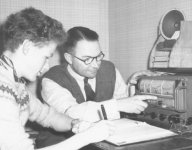OK - spent the last day or so going down the SDR rabbit hole.
Been looking for dual port units to avoid having to have an antenna switch (one for < 30MHz, one for > 30MHz). I know I could buy an Antenna switch, but that is yet another box to fail (Did I say that out loud?).
Specifically when I looked at the Airspy HF+ the older model has dual antenna ports, the newer faster-better-cheaper Discover unit only has a single antenna port. Am I right in presuming I'd need to add a switch for (at least) 2 antennas? Not a killer issue - just hate surprises. Apparently has 18 bit converters. $169 List for the Discover, $199 for the older Dual Port
The Nooelect NESDR Smart v5 has a broader range (100 kHz to 1.75GHz vs. 0.5kHs to 31MHz for the Discovery), but a single antenna port like the Discovery so presumably the same switch need. Kits are cheap at $115 and come up with the Ham It Up Upconverter - which for the uneducated like me is confusing. Why do I need an upconverter???
Also stumbled across the RTL-SDR Blog V3 (and its clones) - very inexpensive ($43 kit), but concerned about it only going to 24MHz in direct sampling mode then needing to be tweaked (setting changed) to go higher. Guessing that would be inconvenient.
Finally looked at the RSPDuo - 3 antenna inputs - priced around $300, 1kHz - 2GHz range. 14 bit converters.
Thoughts?
Reminder: $500 budget
Spark! Love it.
First to answer something. Why an upconverter?
Quote:
Upconverters enable SDRs that cannot tune in the HF bands to receive HF by shifting the low HF frequencies "up" into a range receivable by most VHF/UHF capable SDRs.
Take for example one the SDR's that don't dip down into VLF/HF band. The Airspy Mini.
24 - 1800 MHz. Nothing can be received below 24 MHz. Right.
An upconverter receives those lower frequencies and shifts them up into a frequency that the Mini can receive.
No worries though. No calculators needed to determine the actual frequency you're receiving . SDR software should allow you to put in the upconverter values and display a true frequency.
And. A downconverter would do the same.
But once inline with the radio, they're there (correct me please). I think you need to remove them to restore regular SDR function.
Good news. If the radio can receive 1 kHz-2 gHz continuous. No issues. Upconverter not needed.
Don't get me wrong. I'm not endorsing the SDRPlay radios. It's just one that I know. My next giant step was the IC-R8600. It's an SDR too in an Armani suit!
External antenna switch solved. The Duo has 3 ports. As does the RSPDx.
Something to consider. If you want to ever add a preamplifier for weak signals. Bias-T is a way for the radio to send 4.7 VDC over the coax to an amp. at the antenna. They have it.
Heck. I use a Nooelec LANA low noise amplifier at my RSP2. Not even at the antenna.
I cannot help you make a choice. But reading a few reviews of the radios you're interested in might help. There are tons out there now.
Besides the radio. Software is a big key also. SDR# (SDR Sharp) is big on the RTL, Airspy type radios. Not so sure if later versions support the SDRPlay radios but you may want to take that into consideration.
If scanning and storing frequencies, dabbling in satellite reception, decoding more modern public service frequencies besides plain voice. SDR# has it. I hope you're not a Macintosh/iPad guy. I guess you have to pay for software that works on them. Windows and Linux is another wide-open animal.
Oh. If you do select an SDR radio. Be sure to grab the correct SMA to <your coax termination> adapters also. You will need them.
Get back. Hope some of this helps.


